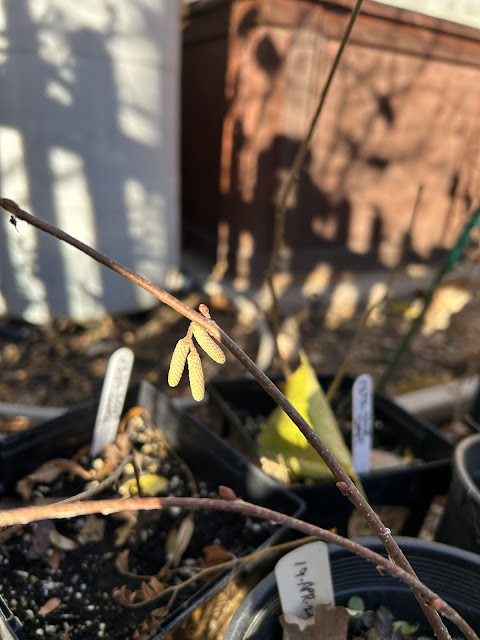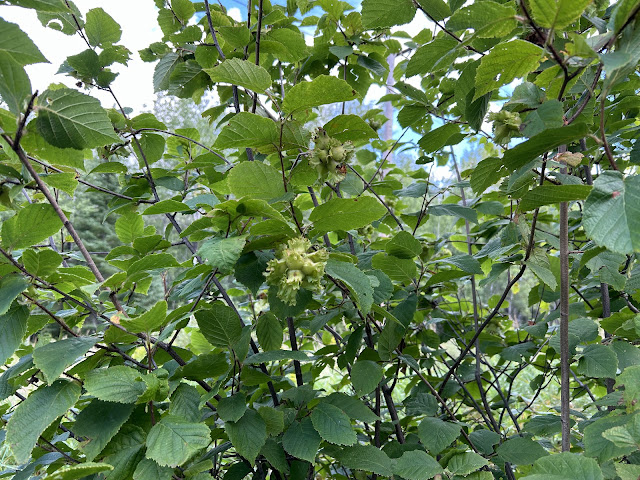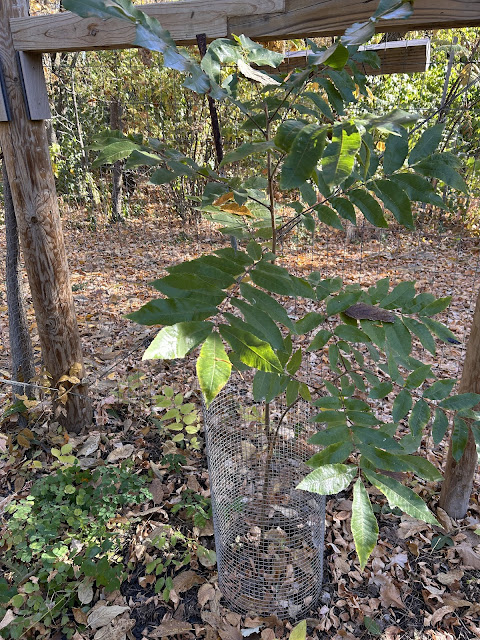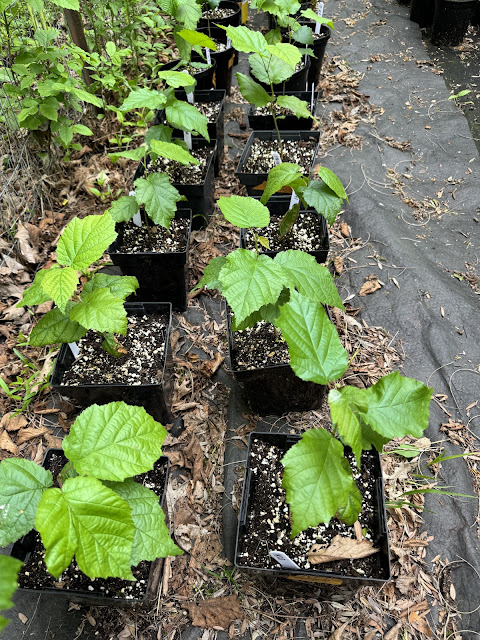Bats in the hazelnuts
I don't mind bats but when picking hazelnuts and your hand comes close to touching one, I jump back swinging my arms. This has happened a couple times, so now I call it the bat dance.
Seed grafting
Jim Walla gave me these grafting clips to try on my seed grafting trials. By April 19 I had only germinated 3 seeds from the seed stock that I planned to use for grafting. The grafting clips worked great and they were much easier then trying to wrap them with ParaFilm around a small stem. Grafting on newly germinated seed is very small work and neither my eyes or hands are as good as they used to be.
The seed grafts on May 1st and looking good.
These 2 pictures are same grafted seedlings this fall after leaf drop. I just could not believe the catkins on these plants. They should be removed to let the plant grow for another year or more before fruiting, but I was so curious to see if these plants would flower and have nuts on next summer.
Spring flowering
This spring was very unusual with temps around 50º F in the first 2 weeks in March. I think one day it was almost 60º. The hazelnuts began to flower, which usually happens around April 15.
The picture above is the catkins (male flowers) beginning to elongate and release pollen.
On this picture you can see the the red female flower appear from the bud. The red female flowers are not very big and one has to look hard to find them. They appear later after the catkins have expanded and started to release pollen.
This is what the hazelnuts looked like on March 14th before the big freeze.
A few days later this is what they looked like with temps never getting above freezing.
This picture was taken on March 27th with the temperature of 18º F
I was hoping some of flowers had been pollinated before the temperature dropped.
After the cold temperature the female flowers on the end of a buds look black.
I read that this not good and the flower will drop off when the leaves appear.
Before the cold snap I collected catkins to cross pollinate some of my best plants.
The elongated catkins are laid out on paper until they release their pollen.
I then shake the catkins and remove them from the paper.
The paper is folded and the pollen is tapped into a small vial.
I keep the small vial in the fridge until I see the female flowers appear on the buds.
After the big freeze on May 1st the temperature began to warm up and I noticed some flowers begin to appear lower down on the shaded side of the hazelnut plants.
I began to hand pollinate by removing the cover of the vial and tipping it over on to my finger.
The next step is to rub that pollen onto this small red flower on the end of the bud.
These are some of the hand pollinated nuts.
There is always something new every year. This is the first year that I've had Sapsucker (woodpecker) damage on hazelnut stems. I counted damage on 8 different hazelnuts. The leaves on these plants were small and the nuts were the size of peas.
I used Tree Tanglefoot on these stems and the Sapsucker disappeared.
Harvest 2024 is not looking good.
Most of the hybrid hazelnuts only had a hand full of nuts, but the wild American hazelnuts (Corylus Americana) had a fair crop. This is my opinion but I think the hybrid hazelnuts tend to bloom earlier than the wild hazelnuts. The wild American hazelnuts seem to be better adapted to our northern climate which is something I hope to pass on to the hybrid hazelnuts.
It also could be location whether in full sun, shade, exposed to wind or in an area with no wind.
Hazelnuts from each plant are in separated drying racks.
They will be dried down until the husk can be removed from the nut.
This may look like a lot of hazelnuts but after the husks are removed and weevil damaged nuts taken out there are not many left.
The nuts with the husk removed are then placed in separate labeled bags.
As you can see there are not many nuts from each plant.
This hazelnut plant had a few more nuts.
This years crop was poor, so picking went fast and I had time to evaluate each plant. It gave me time to decide which plants I will keep or remove.
Every year I always have problems with weevils. I loose about 10% or more to weevils
I try to pick all the nuts on one plant then dry them on racks with trays underneath to catch the weevils.
I have found that more and more weevils are leaving the nuts before they're picked.
This is a picture from a couple years ago when I picked a lot more nuts.
This year the Black Walnuts and Oaks had no nuts or acorns.
I had to fight for every hazelnut from these pests.
Camping Trip
We were camping at McCarthy Beach State Park in Minnesota and I found lots of Beaked Hazelnuts (Corylus Cornuta).
I found it strange that I could not find any wild American Hazelnuts in the park.
While camping we spent one day biking on the Mesabi Trail.
We had a great day on the trail and I could not believe all the American Hazelnuts.
This is a couple pictures of the hazelnuts we saw on the Mesabi Trail.
Fall Colors
This year we seemed to have a long fall with more red and orange colors on lots of the hazelnut plants.
This year I was late putting up cages to protect against deer.
This buck had a great time on one of my best cloned plants.
This buck tore up several hazelnut plants in one night.
I was hoping this buck would disappear during hunting season.
I was wrong he is still here after hunting season and doing more damage.
I think during hunting season he stays close to all the homes in the area with bird feeders. Something has been emptying our bird feeder almost every night.
Here a close up of that same deer from my trail-cam.
Pecans
My Northern Pecans are looking good.
I should have nuts in 2055, can't wait.
Chicken of the woods
Look what I found in my hazelnut orchard. This mushroom is called chicken of the wood and was growing on an old Ash stump.
I really like this mushroom and can't wait to cook them up.
These are a few of the hazelnut seedlings I had for sale.
This is the first time I'm sold out of all the potted plants.
Hope your year was as interesting as mine, remember there is always something new next year.

















































